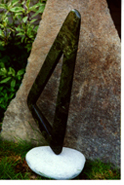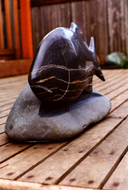In this essay’s first part (Jul./Aug. issue), I discussed my motives for seeking out much of my carving material, characterized my usual terrains for collecting, and used one adventure to show that things don’t always go as planned. This part provides further tips for would-be collectors, presents images of sculptures on bases done with collected stones, and reflects on my growing readiness to purchase stones for my carving.

A strong back, good legs, and outdoor savvy are essential for all would-be stone collectors. So too is a trusty vehicle with adequate carrying capacity for both gear and findings. In many situations, it would certainly be safer to have one or more companions and one or more other vehicles along. However, such arrangements are usually difficult to make. I often end up going off alone and make pre-arranged calls to family or friends about my whereabouts and search plans as I proceed.
Whenever I pack for a daytrip, I divide my needs (besides food and water) into three categories: personal wear, collecting gear, and reconnoitering aids. My main concern in the selection of clothing and the like is to protect myself. To ward off the elements, I take a hat (with cord), waterproof windbreaker, turtleneck(s), trousers, sunscreen, and bug dope. To avoid hand injuries, I bring sturdy gloves. To prevent foot injuries, I use robust boots for dry terrain or a walking stick plus knee-high waders or tough fabric shoes for shorelines and rivers.
My goals in collecting are to liberate stones of possible interest from their settings, to transport the few truly promising ones back to my vehicle, and to get them properly loaded. To view them clearly, I usually rely on my gloves and a simple one-foot bar to get them out of the ground. (A long, heavy bar can also be handy near the road.) To move the best stones to my vehicle, I use variously a 5-gallon plastic bucket (for bowl candidates), a second-hand backpack (for stones up to 100 pounds), and, when the terrain permits, a dolly (for those up to 250 pounds). A section of surplus, medium-gauge net can be quite useful if a companion is along to help with carrying. To load the heavier stones, I usually slide them (netted) up a length of 2 by 8 plank into the carrying space, then wiggle them ahead of the rear wheels, and put dunnage around them to protect their “skins” and the vehicle’s inside walls.
My chief needs when en route to an unfamiliar collecting locale are to know where I am, at the moment, and how to attain my destination. To navigate, I depend mainly on maps of increasing specificity—AAA state maps; DeLorme state atlases; and for greatest detail USFS, BLM, or USGS maps. (A GPS unit is sometimes helpful for fixing one’s actual location in times of uncertainty.)

While crucial, thinking about clothing, gear, and maps is much less stirring than destination planning. A good way to identify potential new search areas is to inquire where fellow sculptors, rock yards, or stone dealers have obtained appealing material. For instance, after I discovered last year that attractive bases could be fashioned from quartzite flagstones, I set about tracking down where rock yards for landscapers get them. I soon learned that most of the nation’s quartzite comes from several outfits headquartered in Oakley (southern Idaho) that have numerous quarries in nearby mountains. Hence, this spring when I wanted to see my daughter in Colorado, I decided to make the visit a driving trip that passed through this source region so that I could search for quartzite in colors, thicknesses, and cobble shapes not carried in rock yards (more below).
Once in a new search area, one should constantly be on the alert for fresh clues about places there to seek out interesting stone. For instance, when en route this spring to the Panamints (a good search area for marble that the Art City folks had told me about the year before), I learned from a brochure at my B&B in Independence that marble quarries across the Owens Valley had once furnished Los Angeles with much building stone. The next morning I spent two hours prospecting the alluvial fans north of “Dolomite” and its surviving aggregate quarry. Because my trip had just begun, I limited my take to about 150 pounds—three pieces: white marble, black marble and intriguing pale-green quartz-feldspar schist. Besides this one brochure, I also got local tips in new search areas this spring from mineral experts at USFS and BLM offices, from rock-yard personnel, from persons with interesting stones in their gardens, and, most especially, from the landforms all around me.
Despite the great enjoyment that I get from collecting for carving, I do find myself buying more stone year by year. One reason for doing so is that some of the hard stones which I like to sculpt are so brittle that they easily break up once on the surface. Hence, to get sizeable pieces of such material, one must buy it from outfits with heavy equipment like West Coast Mining (the source of the jasper from which I carved the “Owyhee Trilogy” in the NWSSA’s Oregon City show).
Another reason is that as I do more sculpting, I find that I want to start off with ever larger stones. Indeed, I’ve reached the point now where some do not fit comfortably into my smallish exploration vehicle. Thus, I was quite happy when I reached Oakley to select three pieces of “turquoise” quartzite (1/2 ton in all) from one of Northern Stone Supply’s yards there for shipment to their Burlington, Washington subsidiary, Cascade Stone Supply. (While making this purchase, I learned that the quarry for this particular quartzite was some 30 miles to the south in Utah’s Raft River Range. I drove down to satisfy my curiosity about the settings of the materials I carve. Along the way, I collected several attractive quartzite cobbles from the alluvial fans adjacent to the roads.)
My last reason for doing more buying is that I am beginning to sell some of my sculptures. Accordingly, until I make the modest investment in time and money to get USFS or BLM permits for commercial collecting, I need to limit my use of finds from these public lands to sculptures for family and friends. This obliges me—at least for the time... being—to buy more stone.

